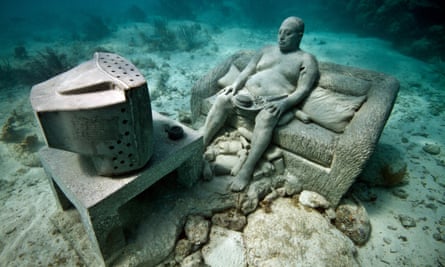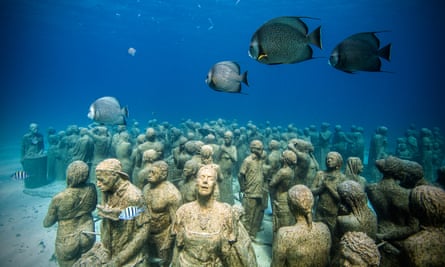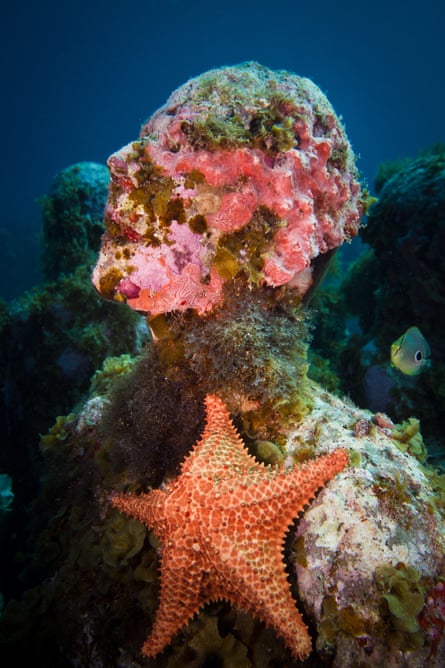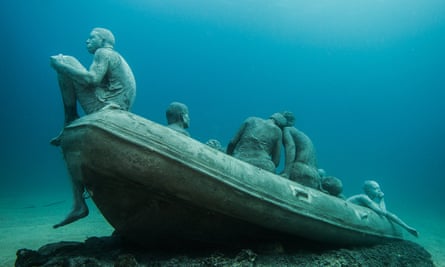On the seabed off the coast of Lanzarote, British artist Jason deCaires Taylor is creating an extraordinary series of underwater artworks, concrete figures representing desperate refugees and selfie-taking tourists that are transformed as they become slowly colonised by marine life
Jason deCaires Taylor is sinking fast. Below, 15 metres under the surface of the sea, a crowd of figures, unmistakably human, are motionless. It is eerily still but for the schools of fish weaving through this newly arrived sunken society.
Taylor has just submerged these sculptures in what will become Europe’s first underwater museum, Museo Atlantico, in Lanzarote. Under the surface of the water, The Raft of Lampedusa, a sculpted boat carrying 13 refugees, is still just visible as it is lowered. Divers surround it, inflatable buoys hold it while Taylor waits with a waterproof clipboard, ready to place it in its new home.
Taylor’s Raft of Lampedusa – a modern take on Géricault’s 1818 painting The Raft of the Medusa – will soon be joined on the seabed by other statues; a faceless couple taking a selfie, people glued to their phones, others wielding an iPad or pointing cameras. Everyone – the boat and its passengers, the “Instagram generation” – will be heading towards a wall, the entrance to a city and the point of no return.
Beyond, a human botanical garden – fantastical hybrids of people and plants drawn from the flora and fauna of Lanzarote. With plans for an underwater fountain, lighting and a giant mirror reflecting a “pool” in the sea, Taylor is clearly aiming for something epic with this thought-provoking journey.
This is the latest in a succession of his underwater installations. The first was in 2006, when he placed Vicissitudes, a ring of beautifully sculpted schoolchildren, on the edge of an ocean shelf, in Molinière Bay, Grenada. That work was instrumental in creating a protected marine park and is now listed as one of National Geographic’s 25 wonders of the world.
Just over a year ago, in the Bahamas, he sank the world’s largest underwater sculpture, the 40-tonne, 16ft Ocean Atlas, positioned near the surface, shouldering the weight of the water. Last summer, with The Rising Tide, he conjured four “horsemen of the apocalypse” in the Thames near the Houses of Parliament, the beasts’ heads – cast from oil wells – revealed in full only at low water.
Taylor is a British artist, a sculptor and photographer; a diver and a naturalist. It is fair to say he’s something of a pioneer. His largest-scale work to date – and, until now, the only underwater museum in the world – is Museo Subacuático de Arte (Musa).
Here, 26ft under the Caribbean in Cancun, Mexico, the work The Silent Evolution, made of nearly 500 statues, was cast from local people in the nearby fishing village of Puerto Morelos. Among the figures, a pregnant woman holds her swollen belly, a child clutches a small bag; the fisherman Joachin raises his head skywards. Last year, I visited the site with Taylor – after his two-year absence, these casts have come to life.
We swim to one statue. A blood-red sponge has spread like scar tissue across her features, softening her expression, outlining her nose, lips and eyes. She is vibrant with colour, her cheeks pulsing with life. Algae trace her hairline, purple acropora coral protrudes from below her chin. Taylor points to lobsters peering out from beneath and nods. All good signs of a healthy, thriving reef.

Inertia, an exhibit at Musa, off the coast of Mexico. Photograph: Jason deCaires Taylor
This work was conceived in 2009 to draw some of the 750,000 annual visitors away from the area’s natural reefs towards the featureless seabed. The once barren seascape has been transformed; the figures, cast in a pH-neutral marine cement, have created a vast, complex artificial reef that supports multiple forms of life.
In return, the ocean has breathed life into the art, thousands of creatures adding their own sculptural abstractions. Taylor’s designs are textured to encourage coral growth, while he attempts to control its direction: “This bit will be really smooth, so the coral doesn’t grow as aggressively on top,” he says, back on dry land, showing me one of his casts.
“But you’ll get coral spawning; it lands on his nose, anchors and starts growing. It’s a bit like our own lives – part of it is what flows in your direction, what nutrients come your way, and part of it is random experience.”
What you end up with is gloriously abstract: faces melting, chests pitted with tiny holes drilled by clams, sea urchins crawling across human necks, feeding at night. Bubble algae – valonia ventricosa, or “sailors’ eyeballs” – cling to one male form. An Atlantis imagined by surrealists, or perhaps by Shakespeare.
“Full fathom five thy father lies/ Of his bones are coral made/ Those are pearls that were his eyes/ Nothing of him that doth fade/ But doth suffer a sea-change/ Into something rich and strange.” In Musa’s shallower site, accessible to swimmers, Self Immolation is breathtaking, lit by the sun’s rays.
The statue has become engulfed in fire coral that Taylor planted on its surrounding framework. Rather than shaping a patina over the figure, these living flames lick up around the head – the coral has become its form.
In Reclamation, a war is taking place – the angel’s wings, formed of gorgonian sea fans rescued from the seabed, are being invaded by fire coral and slowly turning gold. “It’s sending out its army, using the fans as a substrate to filter the nutrients,” Taylor says. “Interesting,” he adds. “I was going to call her The Phoenix.”

Silent Evolution, also at Musa, consists of nearly 500 figures, cast from people of the village of Puerto Morelos. Photograph: Jason deCaires Taylor
“We’ve always seen the sea as this magical place,” says Guardian art critic Jonathan Jones as he looks at photographs of Taylor’s work. “An imaginative element, a place of mystery and of transformation, which is what he’s beautifully exploiting here.” Enthusiastic as he is, the critic isn’t about to get closer: “Is it safe?” he asks.
“Are there sharks?” He’s joking, perhaps, but it does raise interesting points about the audience: who will see this work? Not your habitual Sunday gallery lurkers.
But since at least the 60s, when land artists such as Robert Smithson shook us out of the routine by placing their work in, say, the middle of the desert, art has been escaping the cities for landscapes. Taylor takes that tradition further – and deeper. “It’s a crazy, visionary thing to do,” Jones says. “That you have to put on a snorkel and mask. It’s really about looking.”
Taylor’s intention is to force us to re-examine the sea. “Most of the time,” he says, “we look beyond the sea, to the horizon.” It is significant that he has named his underwater sculpture parks as museums, emphasising the sacred nature of our oceans.
Down here, perspective is turned literally upside down with freedom of movement – it’s as close as most of us will get to travelling in space. “You’re able to imagine much more, not being so rooted to gravity,” he says. “And because you’re making contact with water, you’re almost physically connected.”
People are flocking to see the Musa installations in their thousands. The undeniable wow factor make images of his work eminently shareable and Taylor tracks them on social media. “There was a selfie phase,” he notes in bemusement, and divers “engaging” with the art have caused damage – but he is pragmatic. “As soon as you sink it, you have to let go,” he acknowledges. “It’s difficult, because you spend a lot of time in the studio working on them.”
He had hoped Musa would divert some of the £5 entrance fee towards conservation of this fragile new ecosystem, but this has yet to happen. A few years back, the Musa installation Urban Reef attracted scores of lobsters, but also the attention of local fishermen – the crustaceans disappeared almost overnight. Still, the conservation plan is largely working. Silent Evolution was installed in a patch of sand 500 metres from other reefs.
“Previously, there were no marine species to speak of, and now the cluster of vibrant structures is smothered in life,” says marine biologist Helen Scales. “More than 50 species have been spotted in and around the sculptures including fish lobsters, crabs, algae and coral.”
Coral reefs are in deep trouble worldwide. According to the World’s Resources Institute’s 2011 report, Reefs at Risk, at least 75% are already threatened, and as reefs offer shelter to a quarter of all marine species, that is very bad news indeed. As the oceans absorb the increased carbon dioxide produced by our activities on land, they have become more acidic.
Rising sea temperatures have caused coral bleaching; overfishing and pollution have devastated species on which the ecosystem relies, while bottom dredging and dynamite fishing have decimated seabeds. Biologists are gravely concerned.
It is difficult to make people care – the damage is hidden below the surface, in what for most of us is still an alien environment: “People protect what they love,” Jacques Cousteau once famously said. This philosophy has clearly influenced Taylor.
“Humans only have empathy when they see something of themselves,” he says. “I intentionally made [the figures] very everyday; they all have clothes on – it’s us.” This recognition, he hopes, may move us towards thinking and caring and, eventually, towards action.

Silent Evolution – the Man on Fire. Photograph: Jason deCaires Taylor
In Mexico, the fisherman Joachin draws himself up in front of me, his chest expanding as he strikes a pose. “Don’t you recognise me,” he asks. “Man on Fire!” By chance, on a visit to Puerto Morelos, I have bumped into one of Taylor’s models. Sure enough, he looks familiar – images of his statue, seeded with coral, are some of the most shared online.
Joachin clearly feels a sense of ownership, and of pride. Locals are now aware they have something to protect – and not only because they can earn a small income from tours to the museum: the conservation message is weaved into all aspects of its design.
Viewed from above, Silent Evolution resembles an eye watching over the reef. It spreads 420 square metres and weighs more than 200 tonnes. By any measure, this is a massive installation, yet, in the vastness of the sea, it’s a mere black speck. It takes a special kind of mind to conceive such a world.
Taylor developed an affinity for the sea early on. Born in 1974 to an English father and Guyanese mother, he spent much of his childhood on the Malaysian coast. By secondary school, the family had returned to south-east England, where the teenager lost himself among the derelict buildings and disused railway lines of a new urban landscape. In the early 90s, while a youthful Banksy was experimenting with freehand graffiti art in Bristol’s underground art scene, Taylor was expressing himself with spray paint on walls, buildings and train carriages.
Soon after, he headed to the London Institute of Arts and a BA in sculpture, focusing on man and environment. Meanwhile, inspiration was reaching across the Atlantic from environmental artist Betty Beaumont, who was sinking cinder logs off the coast of New York. Following graduation, Taylor subsidised his artistic endeavours with a number of jobs, including theatre set design: the experience of load bearings, transportation and the ability to think on a large scale would prove invaluable.
A brief stint as a paparazzo (“a low point”) would also be useful – capturing his art’s undersea transformation is an important part of the work, and Taylor has exhibited his photography in the Jonathan Levine Gallery in New York.
By the time he was 30, he was running a dive outfit in Grenada when a relationship breakdown gave him the push to realise his dream. Getting a permit to submerge work from the local authorities was easy; financing it was harder. He took a chance, sold his business and property, worked for months in England, and over a couple of years raised £40,000 to sink in the sea. Back in those days, he did it all by himself; 10 years on, things have changed.
Taylor’s Lanzarote studios sit on a clifftop near the fort by Rubicon harbour, overlooking the Atlantic ocean and the site of the new museum out at sea. Around his terrace are works in progress – heads and limbs are scattered, a ring of delicate figures, children sit in boats cast from oil drums, evoking the local Regata de los jolateros, where they race the homemade vessels.
Outside, apprentices are shovelling cement; inside, assistant Nick Cambden is checking that the barge with the crane is on its way; on the sea wall, chairs are being set up for Pedro San Ginés, the president of Lanzarote, and 200 other dignitaries invited to the unveiling of the work.
Taylor’s art seems different here – these colder Atlantic waters won’t promote the rapid coral growth of the Caribbean, so he is focusing more on detail, in producing stronger dramatic forms, and as his profile and influence grows, the political narrative grows too. Figurative work – often considered cliched in the art world these days – is a powerful tool for communicating on a mass scale. And Taylor clearly has things to say.

The Raft of Lampedusa seen from the front of the boat. Photograph: Jason deCaires Taylor
The Raft of Lampedusa carries 13 passengers towards an unknown future. On the bow of the flimsy inflatable boat sits an African man, his eyes closed, his hand resting on a cheap lifejacket. Abdel Kader, who Taylor cast as the figurehead of this boat, comes from Laayoune, the largest city in Western Sahara. The region’s proximity – 115km from its coastline to the Canary Islands – makes it a profitable departure point for migrant smugglers.
Kader is 29 now – he made the dangerous journey to Lanzarote 16 years ago. By the age of 12, he had lost his sister and father; with 10 brothers and his mother to support, he worked, saved and found his way to the traffickers. Kader remembers being taken across the Sahara in a Land Rover at night to where the small fishing boats – patera – were still being built. To a 12-year-old boy, the vessel looked safe. At sea, the engine stopped and water began to come in.
He remembers the 24 passengers, desperately bailing with whatever they could. He couldn’t swim. “I was worried for my family, who I had to support,” he says. By the fourth day, they were so tired, the pails were lost and the boat was flooded. A fishing boat found them and radioed for the patrol that rescued them. Kader called his mother from Lanzarote. “She cried down the phone. She didn’t know I had left.”
At the back of the sculpture, sprawled helplessly over the starboard side, lies a skeletal figure, cast straight from Théodore Géricault’s 1818 oil painting The Raft of the Medusa. Based on a contemporary event – the sinking of a French navy frigate and the abandonment of 147 souls to a hastily built raft, from which only 15 survived – the painting was seen as an indictment of the French monarchy and political system.
Géricault went to incredible lengths to depict the hellish reality, reconstructing the raft and interviewing survivors, and this icon of Romanticism has inspired artists ever since. But surely it has rarely been so pertinent as now. Even as raft after raft of refugees is lost beneath the waves of the Mediterranean, as the bodies of children wash up on European shores and as Lampedusa’s fishermen find human skulls in their nets, fortress Europe has withdrawn rescue operations, built barriers, turned away.
The Raft of Lampedusa is not meant as a tribute or a memorial, but serves as a reminder of our passivity, and our collective responsibility. “Wherever you put it, this is a powerful sculpture,” says Jones, “a disturbing image of the world we’re creating.”
So what, he wonders, happens when you sink it in the sea? In this place, so often a realm of death, it will be transformed by new life in all its bizarre multiplicity – Taylor expects octopus to colonise it.
“It’s strange,” he concludes. “There’s a sort of dreamlike, redemptive poetry to it.” If you consider that the sea is already a museum littered with artefacts and remnants – wrecks of Carthaginian ships, ancient Greek statues depicting heroes, warriors and gods) – it begs the question: what will future generations make of our modern world as imagined by Taylor?
Passive viewers of television, people taking selfies, this benighted raft of the hungry and hopeless. “Maybe he’s dreaming of a time where humans have been left behind, a nature that’s survived us,” offers Jones. “We might be the forgotten ones.”
News
(VIDEO) Leaked Video PROVES Hollywood PLOT To DESTROY Katt Williams|How Katt Came Back BIGGER & BETTER
**The Untold Saga of Cat Williams: A Journey Through the Darkness of Hollywood** In the ever-evolving landscape of Hollywood, few figures have captivated and confounded audiences quite like Cat Williams. Over the years, his name has become synonymous with controversy,…
(VIDEO) Jada Smith FURIOUS Over LEAKED Will Smith AFFAIR PICS With Margot Robbie!
In the glitzy world of Hollywood, where the line between reality and fiction often blurs, scandals and rumors frequently make headlines, captivating audiences worldwide. One such scandal that has been swirling around Tinsel Town involves two prominent stars: Will Smith…
(VIDEO) Kevin Hart CONFRONT Katt Williams For REVELING His GAY AFFAIRS With HOLLYWOOD Elites
The entertainment industry is no stranger to controversy, and the recent feud between comedians. Kevin Hart and Cat Williams has once again put the spotlight on the dark underbelly of Hollywood. The clash between these two comedic titans has brought…
Diddy THREATENS Katt Williams For Helping The Feds With RAID..
Unveiling the Dark Side of the Music Industry: Allegations Against P. Diddy and Others In recent years, the music industry has been rocked by a series of disturbing allegations against prominent figures, including hip-hop mogul P. Diddy, also known as…
(VIDEO) 7 MINUTES AGO: Denzel Washington SENDS Terrifying Warning To TD Jakes & Diddy To EXPOSE Him
Tinsel Town is abuzz with the latest scandal, this time involving Bishop TD Jakes and his alleged fall from grace. Speculation about his involvement in high-profile events has ignited a storm on social media. Prompting even renowned actor Denzel Washington…
Katt Williams And 50 Cent RELEASE Video Of Diddy Getting Wild With Kevin Hart
Cat Williams Drops Explosive Revelations: Alleges Misconduct by Diddy and Kevin Hart Renowned comedian Cat Williams has once again sent shockwaves through the entertainment industry with. His recent appearance on the Club Shay podcast, where he made startling allegations…
End of content
No more pages to load











